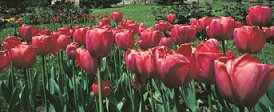Turkey's Flora | All About Turkey (original) (raw)
- Home
- Tourist Info
- Flora
Anatolia is one of the foremost world sources of plants which have been cultivated for food, and the wild ancestors of many plants which now provide staples for mankind still grow here. The Flora of Turkey, same as its fauna, is extremely rich in terms of various species of plants.
 Wild forms develop defense mechanisms against predators, extremes of temperature, flooding, frost and drought. Moreover, they are resistant to the diseases so prevalent among cultivated plants. In addition, they preserve the taste, fragrance, color, hardness and other original characteristics which tend to be lost in the course of cultivation. Today thanks to strides made in biotechnology it is possible to transmit useful qualities of this kind to their cultivars. Moreover, wild forms are a fundamental reference source for the development of new cultivars. To put it metaphorically, wild forms of cultivated species are like the national archive of a country, or the core memory of a computer.
Wild forms develop defense mechanisms against predators, extremes of temperature, flooding, frost and drought. Moreover, they are resistant to the diseases so prevalent among cultivated plants. In addition, they preserve the taste, fragrance, color, hardness and other original characteristics which tend to be lost in the course of cultivation. Today thanks to strides made in biotechnology it is possible to transmit useful qualities of this kind to their cultivars. Moreover, wild forms are a fundamental reference source for the development of new cultivars. To put it metaphorically, wild forms of cultivated species are like the national archive of a country, or the core memory of a computer.
According to the principal international organizations active in wildlife research and conservation-the International Union for the Conservation of Nature (I-UCN), the International Plant Genetic Resource Institute (IPGRI) and the World Wildlife Found, there are four gene centers in the world for cultivated plants used in agriculture. Two of these are in the American continent and two in Asia. In America, Mexico is the gene centre for maize and tomatoes, and Peru for potatoes and beans, while in Asia China is the gene centre for rice and millet, and the region of southwest Asia covering most of Turkey and parts of Iran, Iraq. Syria and Azerbaijan for wheat and barley. The most important of these strategic agricultural plants is undoubtedly wheat, of which over thirty wild species still grow in Turkey. The transmission of a disease-resistant gene from a wild wheat form in Turkey to the American cultivar has meant a saving of 50 million dollars a year for the US economy alone.
 Turkey is also the home of many other cultivated plants, such as chickpeas, lentils, apricots, almonds, figs, hazelnuts, cherries and sour cherries. Their origin is recorded in the Latin names for some of these species, such as Ficus caria, meaning "fig of Caria". Caria was an archaic civilization of Anatolia in the southern Aegean region. Similarly the cherry's scientific name Cerasus comes from the ancient name of its place of origin, today the province of Giresun on Turkey's Black Sea coast.
Turkey is also the home of many other cultivated plants, such as chickpeas, lentils, apricots, almonds, figs, hazelnuts, cherries and sour cherries. Their origin is recorded in the Latin names for some of these species, such as Ficus caria, meaning "fig of Caria". Caria was an archaic civilization of Anatolia in the southern Aegean region. Similarly the cherry's scientific name Cerasus comes from the ancient name of its place of origin, today the province of Giresun on Turkey's Black Sea coast.
Off the large number of ornamental flowers cultivated from Turkish wild forms, we can cite the tulip, crocus, snowdrop, lily and fritillary.
As for the flora, Turkey is divided into 3 main division and 5 subdivisions;
- Euro-Siberian Flora Area
- Kolsik Provence: includes central and western parts of the Black Sea Region and some of Marmara Region.
- Oksin Provence: includes eastern part of the Black Sea Region.
- Mediterranean Flora Area
- Western Anatolia: includes Thrace, southern part of Marmara Region and Aegean Region.
- Taurus Mountains
- Amanos Mountains
- Irano-Tranian Flora Area: includes the rest of the country.